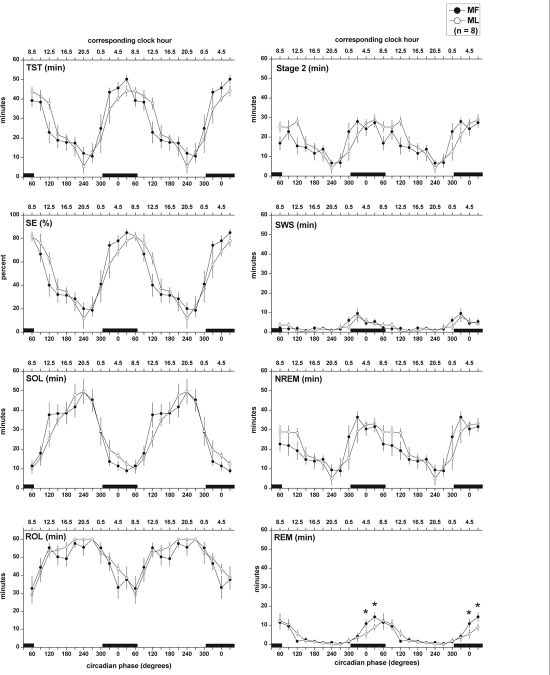Figure 3.
Variation of polysomnographic sleep measures across the circadian cycle at the MF and ML phases of the menstrual cycle obtained throughout the URSW procedure. TST: total sleep time; SE: sleep efficiency; SOL: sleep onset latency; ROL: rapid eye movement sleep onset latency; SWS: slow wave sleep. Two-way ANOVA for repeated measures revealed a significant main effect of circadian phase for all reported sleep parameters (P < 0.0001). *indicates significant menstrual phase differences (P < 0.05) in REM sleep occurring at circadian phase 0° and 30° during ML compared to MF, by Tukey pairwise comparisons. Each 30-sec scored sleep epoch was assigned a circadian phase between 0° to 359.9°, relative to the CBT minimum at 0°. Data were then folded every 24 h, and binned into 30° circadian bins (blocks of 2 h) yielding a 12-point curve spanning the 24-h day. In that manner, data obtained during similar 30° circadian phases throughout the three days of the URSW were combined. SOL and ROL were allocated based on circadian phase at lights out for each nap episode. Data are plotted at the middle of each bin, such that 0° reflects data in the 345° to 15° bin, 30° reflects data from 15° to 45° bin, etc. Data are repeated over 2 consecutive days for illustration purposes. Black bars represent time of projected habitual nocturnal sleep episode (mean ± S.D. circadian phase at bedtime and wake time are 305.9 ± 0.7 and 65.9 ± 0.7 circadian degrees, respectively). All values are mean ± SEM.

